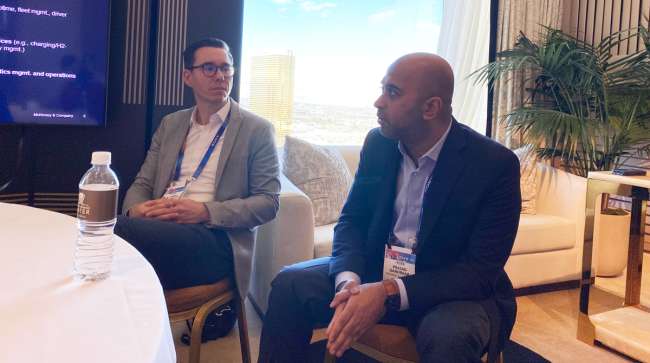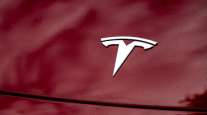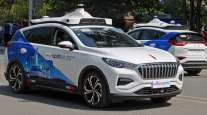Staff Reporter
McKinsey Looks Toward Tech-Driven Future for Trucking

[Stay on top of transportation news: Get TTNews in your inbox.]
LAS VEGAS — McKinsey & Co. shared its expectations of a more technological, integrated and cleaner truck market during CES 2025.
“This is a quick overview of why North America is so important in the overall trucking market,” said Prasad Ganorkar, a partner at McKinsey. “It’s been growing at about 1% or so, or expected to grow at about 1%, [compound annual growth rate]. We do believe that there will be a bit of pre-buying coming up in ’25 and ’26 as the emission regulations change.”
Ganorkar added that pre-buying has been the consensus expectation among truck manufacturers and fleets. That is expected to be followed by a transition toward zero-emission trucks after 2027. He also pointed out that this is based on current regulatory mandates instead of trying to predict any changes that the new Trump administration might pursue.
“We typically don’t talk about regulations and how regulations could change,” Ganorkar said. “But we do believe that given the uncertainty, OEMs and fleets will all need to start having to plan for different scenarios. Because nobody can say today what’s going to happen in the next three or four months. But scenario planning is going to be important.”
PHOTO GALLERY: Images of CES 2025
McKinsey summed up its expectations for the truck market over the next couple decades with five main theses: the current regulatory environment paves the path to zero-emissions trucks; growth in profit pools will only come from new opportunities; autonomous trucking is expected to be total-cost-of-ownership positive after 2030; there will be more alternative business models like truck-as-a-service; and there will be industry reconfiguration.
RELATED: VTNA Launches Volvo on Demand for Class 8 VNR Electric
“The first one really is around the regulatory environment, which we’ve been talking about, and how that fuels the transition to zero-emission technologies,” Ganorkar said. “The main thing that we see currently is that about 25%, roughly, give or take, of medium- and heavy-duty trucks will be electrified in North America. However, to enable that, there will be about $7 billion of investment required in public charging and fueling infrastructure.”
Truck Parking Club's Evan Shelley discusses how innovative platforms are turning available space into opportunities for reserved parking. Tune in above or by going to RoadSigns.ttnews.com.
Ganorkar added that the estimated cost is only for direct investments in the charging and fueling infrastructure. It doesn’t include other needed costs like sites or grid upgrades. He estimated that total costs could end up being 30% to 50% more.
“That’s sort of the investments that will be required to get ready for this transition,” Ganorkar said. “As we start to see the penetration of zero-emission trucks also growing, we expect that the profit pools for the industry [will] start to shift.”
Ganorkar added that OEMs will look for opportunities to engage with the value chain as the industry transitions to electricity. He noted that they are asking what role they can play in electric charging, hydrogen refueling and connectivity to grow revenue and diversify their profits pools.
“The third one really is around autonomous trucking,” Ganorkar said. “That’s probably one of the things that you will see … is a bigger push towards autonomy enablement. That’s happening. Our view is that by 2030, on a pure TCO basis, you will start to see autonomous trucking make sense. But obviously there’s more investment that’s still required to make technology more mature.”
(Transport Topics via YouTube)
Ganorkar added that there is a willingness among customers to look at Level 4 autonomy. Vehicles with autonomous capabilities are typically organized in classes ranging from Level 1 to Level 5. Level 4 does not require human interaction in most circumstances. But a driver can still manually override the vehicle if needed.
“The fourth one that we see … is really new business models,” Ganorkar said. “As you start to see a bunch of these things come together — electrification, electric charging, data connectivity, autonomous — bringing all these things together, it obviously puts a bit of a cost burden, in some ways, on the fleets to enable that and to make sure that it’s all integrated in a seamless manner. There will be new business models that we will start to see.”
Want more news? Listen to today's daily briefing above or go here for more info
Ganorkar added that this has already started happening with a few OEMs offering truck-as-a-service models. There are also third-party providers offering these services. But the expectation is that even more of these models and opportunities will emerge as more of the industry transitions into using these new technologies.
“Then the last one, as we think about these transitions, we do expect a bit of a reconfiguration in terms of how the industry approaches it,” Ganorkar said. “Today, it’s been more of OEMs thinking about selling a truck and then the fleets trying to bring in all the ancillary services together. Increasingly, we expect to see a shift towards a much more holistic, integrated ecosystem of partners coming together. OEMs are partnering already with service providers to make these offerings and bringing them together.”





